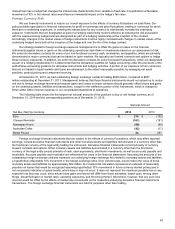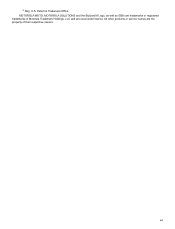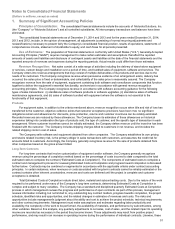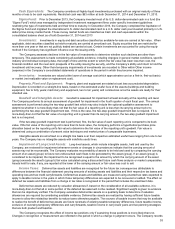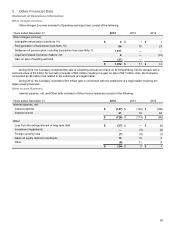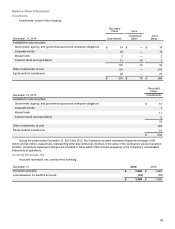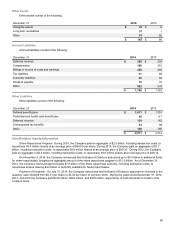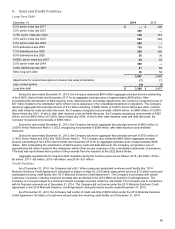Motorola 2014 Annual Report Download - page 55
Download and view the complete annual report
Please find page 55 of the 2014 Motorola annual report below. You can navigate through the pages in the report by either clicking on the pages listed below, or by using the keyword search tool below to find specific information within the annual report.53
Cash Equivalents: The Company considers all highly-liquid investments purchased with an original maturity of three
months or less to be cash equivalents. Restricted cash was $63 million at both December 31, 2014 and December 31, 2013.
Sigma Fund: Prior to December 2013, the Company invested most of its U.S. dollar-denominated cash in a fund (the
“Sigma Fund”) which was managed by independent investment management firms under specific investment guidelines
restricting the type of investments held and their time to maturity. In December 2013, the Company completed the liquidation of
the Sigma Fund and migrated the international U.S. dollar denominated cash to a U.S. dollar cash pool invested primarily in U.S.
dollar prime money market funds. These money market funds are classified as Cash and cash equivalents within the
consolidated balance sheet as of both December 31, 2014 and 2013
Investments: Investments in equity and debt securities classified as available-for-sale are carried at fair value. When
applicable, debt securities classified as held-to-maturity are carried at amortized cost. Equity securities that are restricted for
more than one year or that are not publicly traded are carried at cost. Certain investments are accounted for using the equity
method if the Company has significant influence over the issuing entity.
The Company assesses declines in the fair value of investments to determine whether such declines are other-than-
temporary. This assessment is made considering all available evidence, including changes in general market conditions, specific
industry and individual company data, the length of time and the extent to which the fair value has been less than cost, the
financial condition and the near-term prospects of the entity issuing the security, and the Company’s ability and intent to hold the
investment until recovery. Other-than-temporary impairments of investments are recorded to Other within Other income
(expense) in the Company’s consolidated statements of operations in the period in which they become impaired.
Inventories: Inventories are valued at the lower of average cost (which approximates cost on a first-in, first-out basis)
or market (net realizable value or replacement cost).
Property, Plant and Equipment: Property, plant and equipment are stated at cost less accumulated depreciation.
Depreciation is recorded on a straight-line basis, based on the estimated useful lives of the assets (buildings and building
equipment, five to forty years; machinery and equipment, two to ten years) and commences once the assets are ready for their
intended use.
Goodwill and Intangible Assets: Goodwill is assessed for impairment at least annually at the reporting unit level.
The Company performs its annual assessment of goodwill for impairment in the fourth quarter of each fiscal year. The annual
assessment is performed using the two-step goodwill test which may also include the optional qualitative assessment to
determine whether it is more-likely-than-not that the fair value of a reporting unit is less than its carrying amount prior to
performing the two-step goodwill impairment test. If this is the case, the two-step goodwill impairment test is required. If it is
more-likely-than-not that the fair value of a reporting unit is greater than its carrying amount, the two-step goodwill impairment
test is not required.
If the two-step goodwill impairment test is performed, first, the fair value of each reporting unit is compared to its book
value. If the fair value of the reporting unit is less than its book value, the Company performs a hypothetical purchase price
allocation based on the reporting unit's fair value to determine the fair value of the reporting unit's goodwill. Fair value is
determined using a combination of present value techniques and market prices of comparable businesses.
Intangible assets are amortized on a straight line basis over their respective estimated useful lives ranging from one to ten
years. The Company has no intangible assets with indefinite useful lives.
Impairment of Long-Lived Assets: Long-lived assets, which include intangible assets, held and used by the
Company, are reviewed for impairment whenever events or changes in circumstances indicate that the carrying amount of
assets may not be recoverable. The Company evaluates recoverability of assets to be held and used by comparing the carrying
amount of an asset (group) to future net undiscounted cash flows to be generated by the asset (group). If an asset (group) is
considered to be impaired, the impairment to be recognized is equal to the amount by which the carrying amount of the asset
(group) exceeds the asset's (group's) fair value calculated using a discounted future cash flows analysis or market comparables.
Assets held for sale, if any, are reported at the lower of the carrying amount or fair value less cost to sell.
Income Taxes: Deferred tax assets and liabilities are recognized for the future tax consequences attributable to
differences between the financial statement carrying amounts of existing assets and liabilities and their respective tax bases and
operating loss and tax credit carryforwards. Deferred tax assets and liabilities are measured using enacted tax rates expected to
apply to taxable income in the years in which those temporary differences are expected to be recovered or settled. The effect on
deferred tax assets and liabilities from a change in tax rates is recognized in the period that includes the enactment date.
Deferred tax assets are reduced by valuation allowances if, based on the consideration of all available evidence, it is
more-likely-than-not that all or some portion of the deferred tax asset will not be realized. Significant weight is given to evidence
that can be objectively verified. The Company evaluates deferred tax assets on a quarterly basis to determine if valuation
allowances are required by considering available evidence. Deferred tax assets are realized by having sufficient future taxable
income to allow the related tax benefits to reduce taxes otherwise payable. The sources of taxable income that may be available
to realize the benefit of deferred tax assets are future reversals of existing taxable temporary differences, future taxable income,
exclusive of reversing temporary differences and carryforwards, taxable income in carry-back years and tax planning strategies
that are both prudent and feasible.
The Company recognizes the effect of income tax positions only if sustaining those positions is more-likely-than-not.
Changes in recognition or measurement are reflected in the period in which a change in judgment occurs. The Company records


